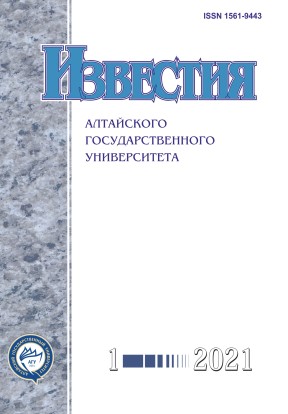Conformally Killing Fields on 2-Symmetric Five-Dimensional Lorentzian Manifolds
УДК 514.742.4
DOI:
https://doi.org/10.14258/izvasu(2021)1-11Keywords:
conformol Killing vector fields, Lorentzian manifolds, k-symmetric spaces, Killing vector fields, Ricci solitonsAbstract
The papers of many mathematicians are devoted to the study of conformally Killing vector fields. Being a natural generalization of the concept of Killing vector fields, these fields generate a Lie algebra corresponding to the Lie group of conformal transformations of the manifold. Moreover, they generate the class of locally conformally homogeneous (pseudo) Riemannian manifolds studied by V.V. Slavsky and E.D. Rodionov. Ricci solitons, which R. Hamilton first considered, are another important area of research. Ricci solitons are a generalization of Einstein's metrics on (pseudo) Riemannian manifolds. The Ricci soliton equation has been studied on various classes of manifolds by many mathematicians. In particular, a general solution of the Ricci soliton equation was found on 2-symmetric Lorentzian manifolds of low dimension, and the solvability of this equation in the class of 3-symmetric Lorentzian manifolds was proved. The Killing vector fields make it possible to find the general solution of the Ricci soliton equation in the case of the constancy of the Einstein constant in the Ricci soliton equation. However, the role of the Killing fields is played by conformally Killing vector fields for different values of the Einstein constant.
In this paper, we investigate conformal Killing vector fields on 5-dimensional 2-symmetric Lorentzian manifolds. The general solution of the conformal analog of the Killing equation on five-dimensional locally indecomposable 2-symmetric Lorentzian manifolds is described in local coordinates, discovered by A.S. Galaev and D.V. Alekseevsky.
Downloads
References
Cao H.-D.Recentprogresson Ricci solitons // Advanced Lectures in Mathematics. 2010. Vol. 1.
Oskorbin D.N., Rodionov E.D. Ricci solitons and killing fields on generalized Cahen-Wallach manifolds // Siberian Mathematical Journal. 2019. Vol. 60. DOI: 10.1134/ S0037446619050136.
Cahen M.,Wallach N. Lorentzian symmetric spaces // Bull. Amer. Math. Soc. 1970. Vol. 76. DOI: 10.1090/S0002-9904-1970-12448-X.
Galaev A.S., Alexeevskii D.V. Two symmetric Lorentzian manifolds // J. Geom. Physics. 2011. Vol. 61. № 12. DOI: 10.1016/j.geomphys.2011.07.005.
Blanco O.F.,Sanchez M., Senovilla J.M. Structure of second-order symmetric Lorentzian manifold // Journal of the European Mathematical Society. 2013. Vol. 15. DOI: 10.4171/JEMS/368.
Galaev A.S., Leistner T. Holonomy groups of Lorentzian manifolds: classification,examples, and applications // Recent Developments in Pseudo-Riemannian Geometry.ESI Lect. Math.Phys., Eur.Math.Soc. Zurich, 2008.
Walker A.G. On parallel fields of partially null vector spaces // Quart. J. Math., Oxford Ser. 1949. Vol. 20. DOI: 10.1093/qmath/os-20.1.135.
Brozos-Vazquez M., Garcia-Rio E., Gilkey P., Nikcevic S., Vazquez-Lorenzo R. The geometry of Walker manifolds. Synthesis Lectures on Mathematics and Statistics. Morgan & Claypool Publ. 2009. DOI: 10.2200/ S00197ED1V01Y200906MAS005.
Wu H. On the de Rham decomposition theorem // Illinois Journal of Mathematics. 1964. Vol. 8. Issue 2. DOI: 10.1215/ijm/1256059674.
Hall G.S. Symmetries and Curvature Structure in General Relativity. World Scientific Publishing Co. Re. Ltd, 2004 DOI: 10.1142/1729.
Downloads
Published
Issue
Section
License
Izvestiya of Altai State University is a golden publisher, as we allow self-archiving, but most importantly we are fully transparent about your rights.
Authors may present and discuss their findings ahead of publication: at biological or scientific conferences, on preprint servers, in public databases, and in blogs, wikis, tweets, and other informal communication channels.
Izvestiya of Altai State University allows authors to deposit manuscripts (currently under review or those for intended submission to Izvestiya of Altai State University) in non-commercial, pre-print servers such as ArXiv.
Authors who publish with this journal agree to the following terms:
- Authors retain copyright and grant the journal right of first publication with the work simultaneously licensed under a Creative Commons Attribution License (CC BY 4.0) that allows others to share the work with an acknowledgement of the work's authorship and initial publication in this journal.
- Authors are able to enter into separate, additional contractual arrangements for the non-exclusive distribution of the journal's published version of the work (e.g., post it to an institutional repository or publish it in a book), with an acknowledgement of its initial publication in this journal.
- Authors are permitted and encouraged to post their work online (e.g., in institutional repositories or on their website) prior to and during the submission process, as it can lead to productive exchanges, as well as earlier and greater citation of published work (See The Effect of Open Access).








